MPLS VPN Routing Model
An MPLS VPN implementation is very similar to a dedicated router peer-to-peer model implementation. From a CE router's perspective, only IPv4 updates, as well as data, are forwarded to the PE router. The CE router does not need any specific configuration to enable it to be a part of a MPLS VPN domain. The only requirement on the CE router is a routing protocol (or a static/default route) that enables the router to exchange IPv4 routing information with the connected PE router.
In the MPLS VPN implementation, the PE router performs multiple functions. The PE router must first be capable of isolating customer traffic if more than one customer is connected to the PE router. Each customer, therefore, is assigned an independent routing table similar to a dedicated PE router in the initial peer-to-peer discussion. Routing across the SP backbone is performed using a routing process in the global routing table. P routers provide label switching between provider edge routers and are unaware of VPN routes. CE routers in the customer network are not aware of the P routers and, thus, the internal topology of the SP network is transparent to the customer. Figure 3-4 depicts the PE router's functionality.
Figure 3-4. MPLS VPN Architecture
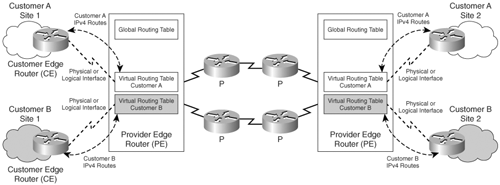
The P routers are only responsible for label switching of packets. They do not carry VPN routes and do not participate in MPLS VPN routing. The PE routers exchange IPv4 routes with connected CE routers using individual routing protocol contexts. To enable scaling the network to large number of customer VPNs, multiprotocol BGP is configured between PE routers to carry customer routes.
VRF: Virtual Routing and Forwarding Table
Customer isolation is achieved on the PE router by the use of virtual routing tables or instances, also called virtual routing and forwarding tables/instances (VRFs). In essence, it is similar to maintaining multiple dedicated routers for customers connecting into the provider network. The function of a VRF is similar to a global routing table, except that it contains all routes pertaining to a specific VPN versus the global routing table. The VRF also contains a VRF-specific CEF forwarding table analogous to the global CEF table and defines the connectivity requirements and protocols for each customer site on a single PE router. The VRF defines routing protocol contexts that are part of a specific VPN as well as the interfaces on the local PE router that are part of a specific VPN and, hence, use the VRF. The interface that is part of the VRF must support CEF switching. The number of interfaces that can be bound to a VRF is only limited by the number of interfaces on the router, and a single interface (logical or physical) can be associated with only one VRF.
The VRF contains an IP routing table analogous to the global IP routing table, a CEF table, list of interfaces that are part of the VRF, and a set of rules defining routing protocol exchange with attached CE routers (routing protocol contexts). In addition, the VRF also contains VPN identifiers as well as VPN membership information (RD and RT are covered in the next section). Figure 3-5 shows the function of a VRF on a PE router to implement customer routing isolation.
Figure 3-5. VRF Implementation on PE Router
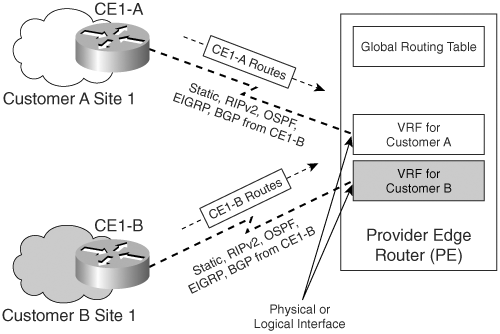
As shown in Figure 3-5, Cisco IOS supports a variety of routing protocols as well as individual routing processes (OSPF, EIGRP, etc.) per router. However, for some routing protocols, such as RIP and BGP, IOS supports only a single instance of the routing protocol. Therefore, to implement per VRF routing using these protocols that are completely isolated from other VRFs, which might use the same PE-CE routing protocols, the concept of routing context was developed.
Routing contexts were designed to support isolated copies of the same VPN PE-CE routing protocols. These routing contexts can be implemented as either separated processes, as in the case of OSPF, or as multiple instances of the same routing protocol (in BGP, RIP, etc.). If multiple instances of the same routing protocol are in use, each instance has its own set of parameters.
Cisco IOS currently supports either RIPv2 (multiple contexts), EIGRP (multiple contexts), OSPFv2 (multiple processes), and BGPv4 (multiple contexts) as routing protocols that can be used per VRF to exchange customer routing information between CE and PE.
Note that the VRF interfaces can be either logical or physical, but each interface can be assigned to only one VRF.
Route Distinguisher, Route Targets, MP-BGP, and Address Families
In the MPLS VPN routing model, the PE router provides isolation between customers using VRFs. However, this information needs to be carried between PE routers to enable data transfer between customer sites via the MPLS VPN backbone. The PE router must be capable of implementing processes that enable overlapping address spaces in connected customer networks. The PE router must also learn these routes from attached customer networks and propagate this information using the shared provider backbone. This is done by the association of a route distinguisher (RD) per virtual routing table on a PE router.
A RD is a 64-bit unique identifier that is prepended to the 32-bit customer prefix or route learned from a CE router, which makes it a unique 96-bit address that can be transported between the PE routers in the MPLS domain. Thus, a unique RD is configured per VRF on the PE router. The resulting address, which is 96-bits total (32-bit customer prefix + 64-bit unique identifier or RD), is called a VPN version 4 (VPNv4) address.
VPNv4 addresses are exchanged between PE routers in the provider network in addition to IPv4 (32-bit) addresses. The format of an RD is shown in Figure 3-6. As shown in Figure 3-6, RD can be of two formats. If the provider does not have a BGP AS number, the IP address format can be used, and, if the provider does have an AS number, the AS number format can be used. Figure 3-6 also shows the same IP prefix, 172.16.10.0/24, received from two different customers, is made unique by prepending different RD values, 1:100:1 and 1:101, prior to propagating the addresses as VPNv4 addresses on the PE router.
Figure 3-6. RD Operation in MPLS VPN
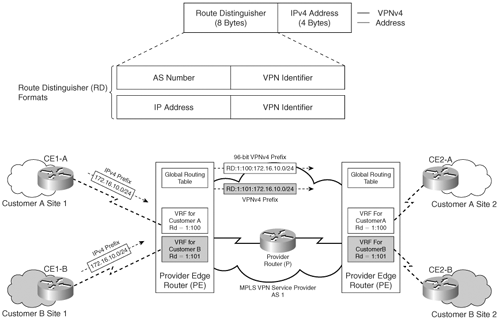
The protocol used for exchanging these VPNv4 routes between PE routers is multiprotocol BGP (MP-BGP). BGP capable of carrying VPNv4 (96-bit) prefixes in addition to other address families is called MP-BGP. The IGP requirement to implement iBGP (internal BGP) still holds in the case of an MPLS VPN implementation. Therefore, the PE router must run an IGP that provides NLRI information for iBGP if both PE routers are in the same AS. Cisco currently supports both OSPFv2 and ISIS in the MPLS provider network as the IGP. MP-BGP is also responsible for assignment of a VPN label. Packet forwarding in an MPLS VPN mandates that the router specified as the next hop in the incoming BGP update is the same router that assigns the VPN label. Scalability was a primary reason for the choice of BGP as the protocol to carry customer routing information. In addition, BGP enables the use of VPNv4 address in an MPLS VPN router environment that enables overlapping address ranges with multiple customers.
An MP-BGP session between PE routers in a single BGP AS is called an MP-iBGP session and follows rules as in the implementation of iBGP with regards to BGP attributes. If the VPN extends beyond a single AS, VPNv4 routes will be exchanged between AS at the AS boundaries using an MP-eBGP session.
Route targets (RTs) are additional identifiers used in the MPLS VPN domain in the deployment of MPLS VPN that identify the VPN membership of the routes learned from that particular site. RTs are implemented by the use of extended BGP communities in which the higher order 16 bits of the BGP extended community (64 total bits) are encoded with a value corresponding to the VPN membership of the specific site. When a VPN route learned from a CE router is injected into VPNv4 BGP, a list of VPN route target extended community attributes is associated with it. The export route target is used in identification of VPN membership and is associated to each VRF. This export route target is appended to a customer prefix when it is converted to a VPNv4 prefix by the PE router and propagated in MP-BGP updates. The import route target is associated with each VRF and identifies the VPNv4 routes to be imported into the VRF for the specific customer. The format of a RT is the same as an RD value. The interaction of RT and RD values in the MPLS VPN domain as the update is converted to an MP-BGP update is shown in Figure 3-7.
Figure 3-7. RT and RD Operation in an MPLS VPN

When implementing complex VPN topologies, such as extranet VPN, Internet access VPNs, network management VPN, and so on, using MPLS VPN technology, the RT plays a pivotal role. A single prefix can be associated to more than one export route target when propagated across the MPLS VPN network. The RT can, as a result, be associated to sites that might be a member of more than one VPN.
The following processes occur during route propagation in an MPLS VPN, as shown in Figure 3-7:
|
1. |
The prefix 172.16.10.0/24 is received from CE1-A, which is part of VRF CustomerA on PE1-AS1. |
|
2. |
PE1 associated an RD value of 1:100 and an export RT value of 1:100 as configured in the VRF definition on the PE1-AS1 router. |
|
3. |
Routes learned from connected CE routers CE1-A are redistributed into the MP-BGP process on PE1-AS1 where the prefix 172.16.10.0/24 is prepended with the RD value of 1:100 and appended with the route target extended community value (export RT) of 1:100 prior to sending the VPNv4 prefix as part of the MP-iBGP update between PE routers. |
|
4. |
The MP-BGP update is received by the PE router PE2, and the route is stored in the appropriate VRF table for Customer A based on the VPN label. |
|
5. |
The received MP-BGP routes are redistributed into the VRF PE-CE routing processes, and the route is propagated to CE2-A. |
In addition, other BGP extended community attributes such as site of origin (SoO) can also be applied to the MP-iBGP update prior to propagation. The SoO attribute is used to identify the specific site from which the PE learns the route and is used in the identification and prevention of routing loops. The SoO extended community is a BGP extended community attribute used to identify routes that have originated from a site so that the re-advertisement of that prefix back to the source site can be prevented, thus preventing routing loops. The SoO extended community uniquely identifies the site from which a PE router has learned a route. SoO enables filtering of traffic based on the site from which it was originated. SoO filtering manages MPLS VPN traffic and prevents routing loops from occurring in complex and mixed network topologies in which the customer sites might possess connectivity across the MPLS VPN backbone as well as possess backdoor links between sites.
The implementation of a MPLS VPN in which all VPN sites belonging to a customer can speak to all other sites in the same customer domain is called a simple VPN implementation or intranet VPN. As mentioned earlier, RTs can be used to implement complex VPN topologies in which certain sites that are part of one customer's domain are also accessible by other customers' VPN sites. This implementation is called an extranet VPN. In addition, variants of extranet VPN, such as network management VPN as well as central services VPN and Internet access VPN, can also be deployed.
It is important to understand the concept of address families and their place in the operation of MP-BGP to enable the transport of VPNv4 routes with extended community attributes. Prior to RFC 2283, "Multiprotocol Extensions for BGP-4," BGP version 4 was capable of carrying routing information only pertaining to IPv4. RFC 2283 defines extensions to BGP-4 that enable BGP-4 to carry information for multiple network layer protocols. RFC 2283 states that to enable BGP-4 to support routing for multiple network layer protocols, the additions to BGP-4 must account for the ability of a particular network layer protocol to be associated with a next hop as well as the NLRI (network layer reachability information). The two new attributes that were added to BGP were Multiprotocol Reachable NLRI (MP_REACH_NLRI), and Multiprotocol Unreachable NLRI (MP_UNREACH_NLRI). MP_REACH_NLRI carries the set of reachable destinations together with the next-hop information to be used for forwarding to these destinations. MP_UNREACH_NLRI carries the set of unreachable destinations. Both of these attributes are optional and nontransitive. Therefore, a BGP speaker that does not support these multiprotocol capabilities will just ignore the information carried in these attributes and will not pass it to other BGP speakers.
An address family is a defined network layer protocol. An address family identifier (AFI) carries an identity of the network layer protocol associated with the network address in the multiprotocol attributes in BGP. (Address family identifiers for network layer protocols are defined in RFC 1700, "Assigned Numbers.")
The PE router, in essence, is an Edge LSR and performs all the functions of an Edge LSR. The PE router requires LDP for label assignment and distribution as well as forward labeled packets. In addition to the functions of an Edge LSR, the PE implements a routing protocol (or static routes) with connected CE routers per virtual routing table and requires MP-BGP to propagate prefixes learned from CE routers as VPNv4 prefixes in MP-iBGP updates to other PE routers along with the VPN label.
The P router's requirements are to run an IGP (either OSPF or ISIS) as well as have MPLS enabled to forward labeled packets (data plane) between PE routers. The IGP is used to provide, as well as propagate, NLRI to connected P and PE routers to implement an MP-iBGP session between PE routers (control plane). As explained in Chapters 1 and 2, LDP is run on the P router for label assignment and distribution.
MPLS VPN Control Plane Operation
The control plane in MPLS VPN implementation contains all the Layer 3 routing information and the processes within to exchange reachability information for a specific Layer 3 IP prefix in addition to label assignment and distribution using LDP (as explained in Chapter 1). The data plane performs the functions relating to the forwarding of both labeled as well as IP packets to the next hop toward a destination network. Figure 3-8 outlines the interactions of protocols in the control plane in an MPLS VPN implementation.
Figure 3-8. Control Plane Interactions in MPLS VPN
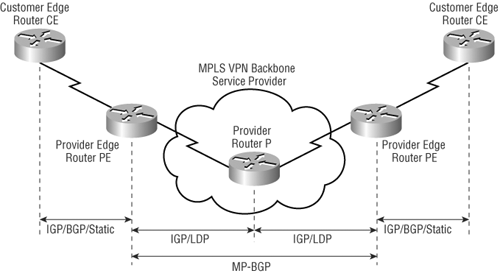
The CE routers are connected to the PE routers, and an IGP, BGP, or static route is required on the CE routers in conjunction with attached PE routers to gather and advertise NLRI information. In the MPLS VPN backbone consisting of P and PE routers, an IGP (usually either OSPF or ISIS) in addition to LDP is used between PE and P routers. LDP is used for allocation as well as distribution of labels in the MPLS domain. The IGP is used for NLRI information exchange as well as to map this NLRI into MP-BGP. MP-BGP sessions are maintained between PE routers in an MPLS VPN domain and exchange MP-BGP updates consisting of unique VPNv4 addresses in addition to BGP extended community attributes associated with specific VPNv4 addresses.
Packets from CE to PE are always propagated as IPv4 packets. Operation of the MPLS VPN control plane is shown in Figure 3-9. Figure 3-9 shows a simple VPN implementation with two sites belonging to Customer A connected to one another across a service provider's MPLS backbone.
Figure 3-9. Control Plane Operation
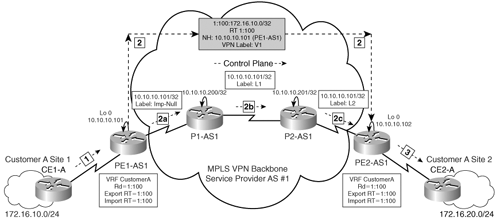
The following are the steps for control plane operation in MPLS VPN. The steps are outlined for prefixes advertised by the CEA-1 router and are shown in Figure 3-9:
|
Step 1. |
IPv4 update for network 172.16.10.0 is received by the egress PE router (data plane). |
|
Step 2. |
PE1-AS1 accepts and transforms the IPv4 route, 172.16.10.0/24, to a VPNv4 route by assigning an RD 1:100, SoO, and RT 1:100 based on the VRF configuration on PE1-AS1. It then allocates a VPNv4 label V1 to the 172.16.10.0/24 update and rewrites the next-hop attribute to the PE1-AS1 loopback0 IP address 10.10.10.101. PE1-AS1 loopback 10.10.10.101 is reachable via IGP (OSPF) and LDP. Figure 3-9 shows the control plane operation and the label propagation for prefix 10.10.10.101/32 from PE1-AS1 to PE2-AS1 inside the provider network. This propagation takes place as soon as the MPLS VPN provider network is established and is always in place prior to any VPNv4 prefix being propagated across the MPLS VPN provider network. The following steps are performed in the label propagation process for prefix 10.10.10.101/32. This operation is shown for clarity:
|
|
Step 3. |
PE1-AS1 has the VRF configured to accept routes with RT 1:100 and therefore translates the VPNv4 update to IPv4 and inserts the route in VRF for Customer A. It then propagates this route to the CE2-A. |
MPLS VPN Data Plane Operation
The prior section discussed update propagation along with the label assignment and distribution, both for MPLS packet forwarding as well as the VPN label. MPLS VPN data plane operation involves the usage of the label stack in which the top label in the label stack is the label assigned for the egress PE routers (data plane) next-hop address, and the second label in the label stack is the VPN label as assigned by the egress PE router connected to the CE router advertising the prefix. When using the label stack in an MPLS VPN implementation, the ingress/upstream PE router thus labels the incoming IP packet for a remote VPN destination with two labels.
The second label in the stack points toward an outgoing interface whenever the CE router is the next hop of the VPN route. The second label in the stack points to the VRF table for aggregate VPN routes, VPN routes pointing to null interface, and routes for directly connected VPN interfaces. This will be explained in more detail in the section "MPLS VPN Basic Configuration." P routers perform label switching on the LDP-assigned label toward the egress PE router. The egress PE router identifies the VPN label assigned with a VRF (that it has previously assigned) and either forwards the IP packet toward the CE router or performs another IP lookup in the VRF table to identify the next hop toward the destination.
Figure 3-10 depicts the various steps in the data plane forwarding of customer data from one customer site CE2-A to CE1-A connected using the SP's infrastructure.
Figure 3-10. MPLS VPN Data Plane Operation
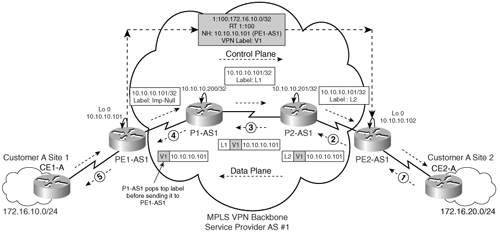
When data is forwarded to a specific prefix belonging to a VPN across the MPLS-enabled core, the top label in the label stack is the only one swapped as the packet traverses the backbone. The VPN label is kept intact and is removed only in the egress/downstream PE router. The resulting prefix is associated with an outgoing interface belonging to a specific VRF on the router depending on the value in the VPN label.
Here are the steps in the data plane forwarding shown in Figure 3-10:
|
Step 1. |
CE2-A originates a data packet with the source address of 172.16.20.1 and destination of 172.16.10.1. |
|
Step 2. |
PE2-AS1 receives the data packet and appends the VPN label V1 and |
|
Step 3. |
P2-AS1 receives the data packet destined to 172.16.10.1 and swaps LDP label L2 with L1. |
|
Step 4. |
P1-AS1 receives the data packet destined to 172.16.10.1 and pops the top label because it receives an implicit-null label mapping for 10.10.10.101/32 from PE1-AS1. The resulting labeled packet (with VPN Label V1) is forwarded to PE1-AS1. |
|
Step 5. |
PE1-AS1 pops the VPN label and forwards the data packet to CE1-A where the 172.16.10.0 network is located. |
The key to understanding the operation of MPLS VPN is that the VPN label is never touched until it reaches the egress PE router toward the FEC. All the forwarding of traffic is done as explained in Chapter 1; the next-hop label mapping to the downstream PE router's loopback is used to forward the packet (in this case, labeled IP because of the presence of a VPN label) through the MPLS domain.
MPLS Overview
- MPLS Overview
- Unicast IP Forwarding in Traditional IP Networks
- Overview of MPLS Forwarding
- MPLS Terminology
- MPLS Control and Data Plane Components
- MPLS Operation
- Special Outgoing Label Types
- Penultimate Hop Popping
- Frame-Mode MPLS
- Cell-Mode MPLS
Basic MPLS Configuration
- Basic MPLS Configuration
- Frame-Mode MPLS Configuration and Verification
- Cell-Mode MPLS over ATM Overview, Configuration, and Verification
- Command Reference
Basic MPLS VPN Overview and Configuration
- Basic MPLS VPN Overview and Configuration
- VPN Categories
- MPLS VPN Architecture and Terminology
- MPLS VPN Routing Model
- MPLS VPN Basic Configuration
- Outbound Route Filters
- Command Reference
PE-CE Routing Protocol-Static and RIP
- PE-CE Routing Protocol-Static and RIP
- Static PE-CE Routing Overview, Configuration, and Verification
- Static PE-CE Routing Command Reference
- RIPv2 PE-CE Routing Overview, Configuration, and Verification
- RIPv1 PE-CE Routing Configuration and Verification
- RIP PE-CE Routing Command Reference
PE-CE Routing Protocol-OSPF and EIGRP
- PE-CE Routing Protocol-OSPF and EIGRP
- OSPF PE-CE Routing Protocol Overview, Configuration and Verification
- EIGRP PE-CE Routing Protocol Overview, Configuration, and Verification
Implementing BGP in MPLS VPNs
- Implementing BGP in MPLS VPNs
- BGP PE-CE Routing Protocol Overview, Configuration, and Verification
- Implementing Route-Reflectors in MPLS VPN Networks
- Case Study-Hub and Spoke MPLS VPN Network Using BGP PE-CE Routing for Sites Using Unique AS Numbers
- Case Study-Hub and Spoke MPLS VPN Network with Sites Using Same AS Numbers
- Command Reference
Inter-Provider VPNs
- Inter-Provider VPNs
- Overview of Inter-Provider VPNs
- Option 1: Inter-Provider VPN Using Back-to-Back VRF Method
- Option 2: Inter-Provider VPNs Using ASBR-to-ASBR Approach
- Option 3: Multi-Hop MP-eBGP Between RR and eBGP Between ASBRs
- Option 4: Non-VPN Transit Provider
- Case Study-Inter-AS Implementing Route-Reflector and BGP Confederation in Provider Networks
- Case Study-Multi-Homed Inter-AS Provider Network
- Command Reference
Carrier Supporting Carriers
- Carrier Supporting Carriers
- Carrier Supporting Carriers Overview
- Deployment Scenarios with CSC Architecture
- CSC Architecture Benefits
- Command Reference
MPLS Traffic Engineering
- MPLS Traffic Engineering
- TE Basics
- MPLS TE Theory
- Constraint-Based Routing and Operation in MPLS TE
- Configuring MPLS TE
- Command Reference
Implementing VPNs with Layer 2 Tunneling Protocol Version 3
- Implementing VPNs with Layer 2 Tunneling Protocol Version 3
- L2TPv3 Overview
- Configuring L2TPv3 Tunnels for Layer 2 VPN
- Configuring L2TPv3 Static Tunnels
- Configuring L2TPv3 Dynamic Tunnels
- Implementing Layer 3 VPNs over L2TPv3 Tunnels
- Command Reference
Any Transport over MPLS (AToM)
- Any Transport over MPLS (AToM)
- Introduction to Layer 2 VPNs
- Implementing AToM for Like to Like Circuits
- L2 VPN-Any to Any Interworking
- Local Switching
- Command Reference
Virtual Private LAN Service (VPLS)
- Virtual Private LAN Service (VPLS)
- VPLS Overview
- VPLS Topology-Single PE or Direct Attachment
- Hierarchical VPLS-Distributed PE Architecture
- Command Reference
Implementing Quality of Service in MPLS Networks
- Implementing Quality of Service in MPLS Networks
- Introduction to QoS-Classification and Marking
- MPLS QoS Implementation
- MPLS QoS Operating Modes
- Modular QoS CLI: Configuration of QoS on Cisco Routers
- Configuration and Implementation of MPLS QoS in Uniform Mode and Short Pipe Mode Operation
- Implementing MPLS QoS for Layer 2 VPN Implementations
- Command Reference
MPLS Features and Case Studies
- MPLS Features and Case Studies
- Case Study 1: Implementing Multicast Support for MPLS VPNs
- Case Study 2: Implementing Multi-VRF CE, VRF Selection Using Source IP Address, VRF Selection Using Policy-Based Routing, NAT and HSRP Support in MPLS VPN, and Multicast VPN Support over Multi-VRF CE
- Case Study 3: Implementing Layer 2 VPNs over Inter-AS Topologies Using Layer 2 VPN Pseudo-Wire Switching
- Case Study 4: Implementing Layer 3 VPNs over Layer 2 VPN Topologies and Providing L2 VPN Redundancy
- Case Study 5: Implementing Dynamic Layer 3 VPNs Using mGRE Tunnels
- Case Study 6: Implementing Class-Based Tunnel Selection with MPLS Traffic Engineering
- Case Study 7: Implementing Hub and Spoke Topologies with OSPF
- Case Study 8: Implementing Hub and Spoke Topologies with EIGRP
- Case Study 9: Implementing VPLS Services with the GSR 12000 Series
- Case Study 10: BGP Site of Origin
- Command Reference
EAN: 2147483647
Pages: 130
